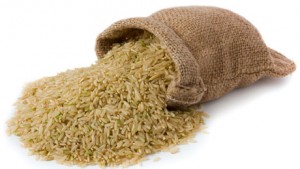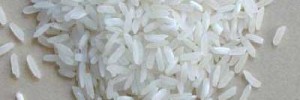The two different types of rice
There are essentially two kinds of rice: long and short grain. (Technically, almost all rice is Oryza sativa and, within that species, there are 0. sativa indica, long grain, and 0. sativa japonica, short grain.) But within each of those categories are many, many varieties (probably forty thousand or more in all), and many different ways in which the basic grain is treated.
By far the majority of rice eaten is long grain, although Asian immigrants and our newfound love for risotto are changing that. Long-grain rice, handled correctly, cooks in separate, firm, dry kernels, a tendency that can be enhanced by cooking the rice in butter or oil before adding liquid. Basmati and most other aromatic rices are long grain.
Short-grain (and so-called medium-grain) rice cooks up soft, moist, and a little sticky, because its outer layer softens readily and absorbs more liquid – and also more flavor — than long-grain rice (or, in fact, any other commonly cooked starchy food). This tendency can be mitigated by cooking the rice gently, or taken advantage of by stirring the rice during cooking — as in risotto — which allows more of the starch to leach out, making for a rice dish that is downright creamy.
The other major distinction in rice is how it is milled. Like many other grains, all rice grows with a husk. Inside the husk, which is always removed, is a layer of bran. Brown rice is rice with an intact bran layer. It takes longer to cook, largely because it takes longer for the water to penetrate the bran layer and soften the starch, and it never becomes soft — bran is largely unaffected by cooking. It is more nutritious than white rice (even “enriched” white rice), especially in its thiamine content. But since most Americans don’t eat rice for its nutrients, this isn’t necessarily important.
Brown Rice
 Brown rice also contains far more fiber, a distinct advantage. But the culinary history of grains is the history of refinement: People generally prefer white rice, pearled barley, and white flour; it’s not a choice that people make based on nutrients. For those who want to compromise, there is rice that is milled so that it falls halfway between brown and white rice, and has some of the qualities of each — faster cooking than brown rice, it’s a little crunchier than white, with a higher fiber content.
Brown rice also contains far more fiber, a distinct advantage. But the culinary history of grains is the history of refinement: People generally prefer white rice, pearled barley, and white flour; it’s not a choice that people make based on nutrients. For those who want to compromise, there is rice that is milled so that it falls halfway between brown and white rice, and has some of the qualities of each — faster cooking than brown rice, it’s a little crunchier than white, with a higher fiber content.
So most rice is “white”: The bran is completely removed, and the kernel fully milled, or polished. Some white rice is parboiled or “converted” (such as Uncle Ben’s), which means it is steamed before milling. This process forces some of the nutrients back into the kernel, making the rice somewhat more nutritious than other white rice (but still less so than brown rice). But converted rice is relatively expensive, and does not have the flavor of “ordinary” white rice. Instant (“minute”) rice is precooked; you just reconstitute it at home. But it is expensive, and its flavor is closer to that of cardboard than to most other rices; since rice cooking is easy anyway, you don’t need it.
I recommend buying standard white rice, whether long- or short-grain, in five- or ten-pound bags. I recommend that you buy domestic product, for two reasons: The United States is a minor but significant producer and exporter of rice, and our production is high quality; and some imported rice is coated with talc, and requires a thorough washing before use. Just look for a good price, and for unbroken kernels. Note that much American rice is called Carolina rice (and, of course, Carolina is also a brand name), but little rice is actually grown in the Carolinas anymore.
As for the more subtle distinctions among specialty rices:
- Basmati is the most important long-grain specialty rice. It is extra-long-grain, thin, cream-colored, and intensely aromatic, filling the kitchen with an alluring aroma from the moment it begins to cook. Most basmati is imported, making it relatively expensive, but it is incomparable stuff. There are other aromatic rices – Texmati, Wild Pecan, Popcorn (all brand names) — and they are good. But they are usually no less expensive than imported basmati.
- Wehani is another domestic aromatic long grain, but it’s sold brown — that is, unpolished. It has a deep bronze-brown color and a very sweet flavor—nice stuff. It can be cooked and used like regular brown rice.
- Jasmine rice is also long grain, and also aromatic. But it cooks as if it were short grain; that is, moist and somewhat sticky. It has a wonderful aroma and flavor, and is associated with Thai food.
- Short-grain rice seems exotic to many Americans, but it is a standard product throughout most of the rest of the world, where it is preferred to long-grain varieties. To us, the most important specialty short-grain rices are Arborio and its cousins (Vialone Nano, Roma, Carnaroli, and so on), all of which are grown in northern Italy (or eastern Spain), and which are used almost exclusively to make risotto (or paella). You will most easily find Superfino Arborio, and that’s what you want. Note that any short- or medium-grain rice will make acceptable risotto. Arborio gives the best results, but if you must resort to other short-grain rice for reasons of economy (Arborio costs five times as much as standard rice) or convenience (not every supermarket stocks Arborio), don’t worry about it.
- Other short-grain rices worth noting are red rice, a brown short-grain not unlike Wehani; black rice, a semipolished rice that is nice to cook with white rice (and will stain it purple); sticky (or glutinous) rice, a very-short-grain Asian rice that is, as you’ve already guessed, very sticky, and is great for desserts.
- Wild rice, by the way, is not a rice but a grass.
Cooking rice is easy, or should be. In fact, it’s so easy that there’s hardly a method that won’t work for it (you can cook rice in a pressure cooker or microwave but — with the exception of brown rice — it won’t save you any time, and it certainly isn’t more convenient). Basically, you cook it like pasta, or you combine it with one and a half to two times as much water and cook until the water is absorbed. If you cook rice every day, you might want to investigate an electric rice cooker, which works automatically and quite well. But there are many subtleties involved in cooking rice.
